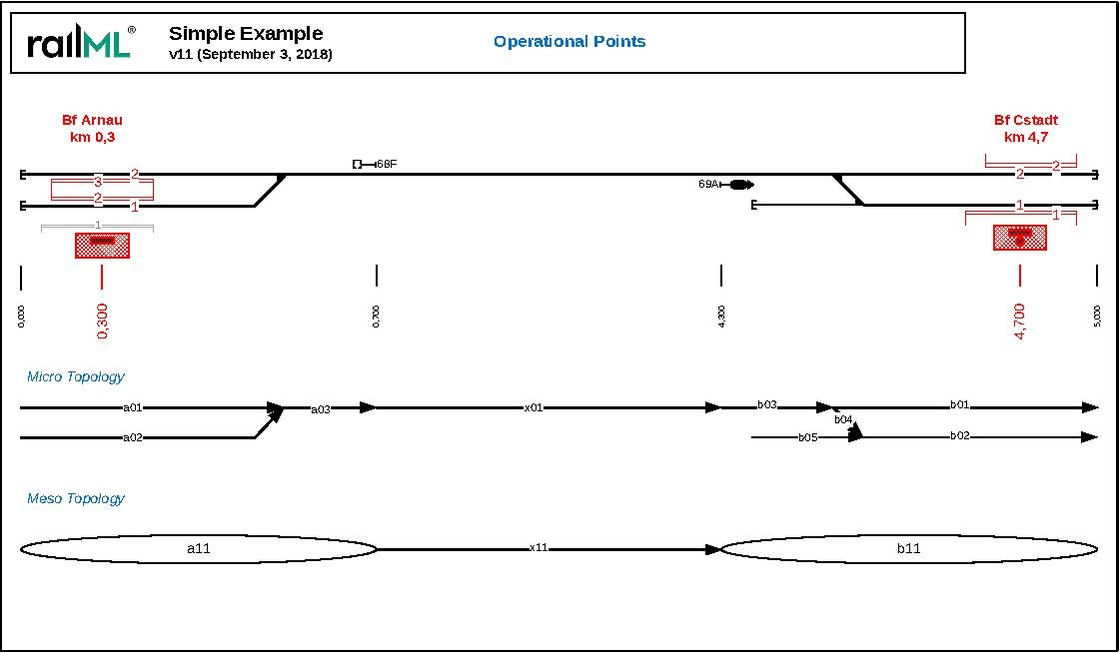Introduction
Documentation
Syntax
|
|
| Documentation
|
container element for all operationalPoint elements
|
| Subschema
|
infrastructure
|
| Parents*
|
functionalInfrastructure
|
| Children
|
operationalPoint (1..*)
|
| Attributes:None
|
*Notice:
Elements may have different parent elements. As a consequence they may be used in different contexts.
Please, consider this as well as a user of this Wiki as when developing this documentation further.
Aspects that are only relevant with respect to one of several parents should be explained exclusively in the documentation of the respective parent element.
|
|
|
| Documentation
|
container element for all operationalPoint elements
|
| Subschema
|
infrastructure
|
| Parents*
|
functionalInfrastructure
|
| Children
|
operationalPoint (1..*)
|
| Attributes:None
|
*Notice:
Elements may have different parent elements. As a consequence they may be used in different contexts.
Please, consider this as well as a user of this Wiki as when developing this documentation further.
Aspects that are only relevant with respect to one of several parents should be explained exclusively in the documentation of the respective parent element.
|
|
|
| Documentation
|
container element for all operationalPoint elements
|
| Subschema
|
infrastructure
|
| Parents*
|
functionalInfrastructure
|
| Children
|
operationalPoint (1..*)
|
| Attributes:None
|
*Notice:
Elements may have different parent elements. As a consequence they may be used in different contexts.
Please, consider this as well as a user of this Wiki as when developing this documentation further.
Aspects that are only relevant with respect to one of several parents should be explained exclusively in the documentation of the respective parent element.
|
Changes 3.1→3.2
There exists an overview of all changes between railML® 3.1 and railML® 3.2 on page Dev:Changes/3.2.
The parents have been changed.
The children have been changed.
Changes 3.2→3.3
There exists an overview of all changes between railML® 3.2 and railML® 3.3 on page Dev:Changes/3.3.
The parents have been changed.
The children have been changed.
Semantics
Best Practice / Examples
The Simple Example contains two operational control points in the form of stations. Their names are "Bf Arnau" and "Bf Cstadt" and they are located at the beginning and the end of the railway line. The center of "Bf Arnau" is located at kilometer 0.300, and the center of "Bf Cstadt" is located at kilometer 4.700, as shown in the following figure.
In order to locate the <operationalPoint> elements within the topology network (<netElement> “a11” and <netElement> “b11”) the child element <spotLocation> is being used. Considering the mesoscopic topology network station “Bf Arnau” is located on the <netElement> “a11” and station “Bf Cstadt” is located on the <netElement> “b11”. Since both referenced <netElement> objects are non-linear objects, their intrinsic position equals “0”. The <spotLocation> element further implements the linking between the (topologic) intrinsic location and the railway line coordinates mentioned above.
Please note: An <operationalPoint> is modelled as part of the <functionalInfrastructure>. Thus, it is independent of the underlying topology that it references.
Both operational points also have designators, which act like external identifiers in a given register. In particular, "Bf Arnau" has the code "OAR" in the register named "RL100" and "Bf Cstadt" is designated with the RL100 code "OCS". The specification of the operational aspects of the operational points is given in the child element <opOperations>. With the child element <name>, the operation point (e.g. in different languages) can be defined with different names. The child element <opEquipment> can be used to explicitly list infrastructure elements that belong to this operational point, e.g. <platform> edges or signals. The resulting railML code snippet looks like this:
<infrastructure id="is_01">
...
<functionalInfrastructure>
<operationalPoints>
<operationalPoint id="opp01">
<name name="Bf Arnau" language="de"/>
<name name="Adamov" language="cz"/>
<spotLocation id="opp01_sloc01" netElementRef="ne_a11" applicationDirection="both">
<linearCoordinate positioningSystemRef="lps01" measure="300.0"/>
</spotLocation>
<designator register="RL100" entry="OAR"/>
<opEquipment>
<ownsPlatform ref="plf01"/>
</opEquipment>
<opOperations>
<opOperation operationalType="station" trafficType="passenger"/>
</opOperations>
</operationalPoint>
<operationalPoint id="opp02">
<name name="Bf Cstadt" language="de"/>
<name name="Bouzov" language="cz"/>
<spotLocation id="opp02_sloc01" netElementRef="ne_b11" applicationDirection="both">
<linearCoordinate positioningSystemRef="lps01" measure="4700.0"/>
</spotLocation>
<designator register="RL100" entry="OCS"/>
<opEquipment>
<ownsPlatform ref="plf02"/>
<ownsPlatform ref="plf03"/>
</opEquipment>
<opOperations>
<opOperation operationalType="station" trafficType="passenger"/>
</opOperations>
</operationalPoint>
</operationalPoints>
</functionalInfrastructure>
</infrastructure>
Additional Information
Notes
Open Issues
